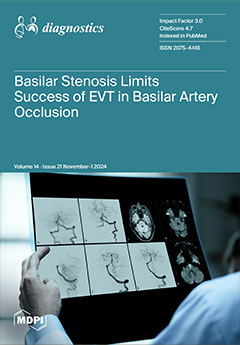Background: Fluoroscopy-guided PTNB for fluoroscopy-identifiable lung lesions has been suggested as a useful method for the pathological diagnosis of lung lesions; however, it is lacking in accuracy and safety compared to CT-guided PTNB. Thus, we aimed to investigate the diagnostic accuracy and complications
[...] Read more.
Background: Fluoroscopy-guided PTNB for fluoroscopy-identifiable lung lesions has been suggested as a useful method for the pathological diagnosis of lung lesions; however, it is lacking in accuracy and safety compared to CT-guided PTNB. Thus, we aimed to investigate the diagnostic accuracy and complications of fluoroscopy-guided percutaneous transthoracic needle biopsy (PTNB) with the aid of pre-procedural planning cone-beam computed tomography (CBCT) in order to take advantage of their respective strengths.
Methods: A total of 255 fluoroscopy-guided PTNBs with the aid of planning CBCT were performed. Pre-procedural planning CBCT was conducted to calculate the shortest length from the skin puncture site to the margin of the target lesion for the needle trajectory. No intra-procedural CBCT was performed. The diagnostic performance of fluoroscopy-guided PTNB with the aid of planning CBCT was calculated. The prognostic factors for diagnostic failures and complications were evaluated using logistic regression analysis.
Results: The accuracy, sensitivity, specificity, PPV, and NPV were 97.3%, 88.0%, 90.9%, 100%, and 62.5%, respectively. There were 29 diagnostic failures (11.8%), and the multivariable analysis showed that a longer lesion depth on CBCT and a shorter specimen length were each associated with diagnostic failure (
p = 0.010 and 0.012, respectively). Complications occurred in 34 PTNBs (13.3%). The multivariable analysis showed that an increased total number of biopsies per lesion, a longer length of lung aeration via needle insertion, a smaller lesion size on CT imaging (≤20 mm), and the presence of an air bronchogram were associated with the occurrence of complications (
p = 0.027, <0.001, 0.003, and 0.020, respectively).
Conclusions: Excellent diagnostic accuracy was obtained by fluoroscopy-guided PTNB with the aid of planning CBCT. Compared to that of CT- or CBCT-guided PTNB, the procedure-related complication rate was acceptably low, but the radiation dose to patients could be potentially reduced.
Full article






